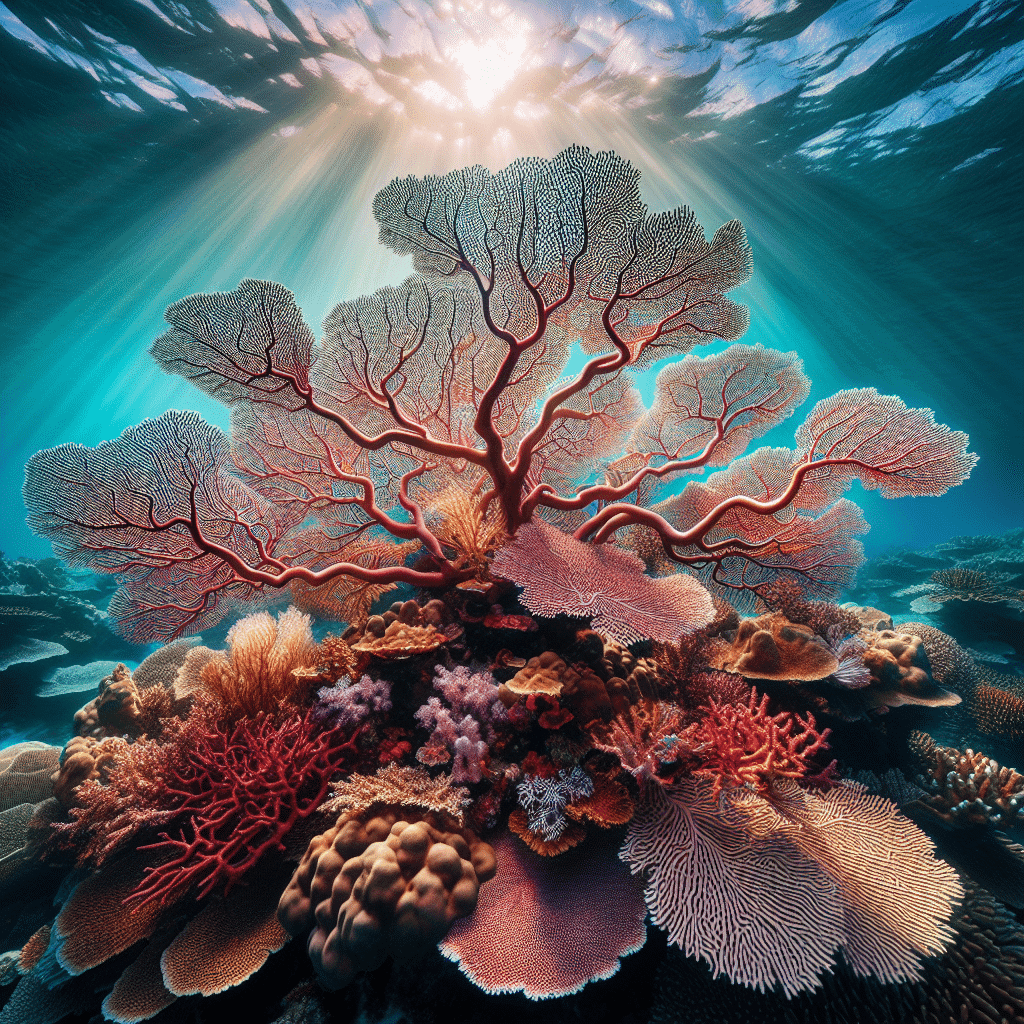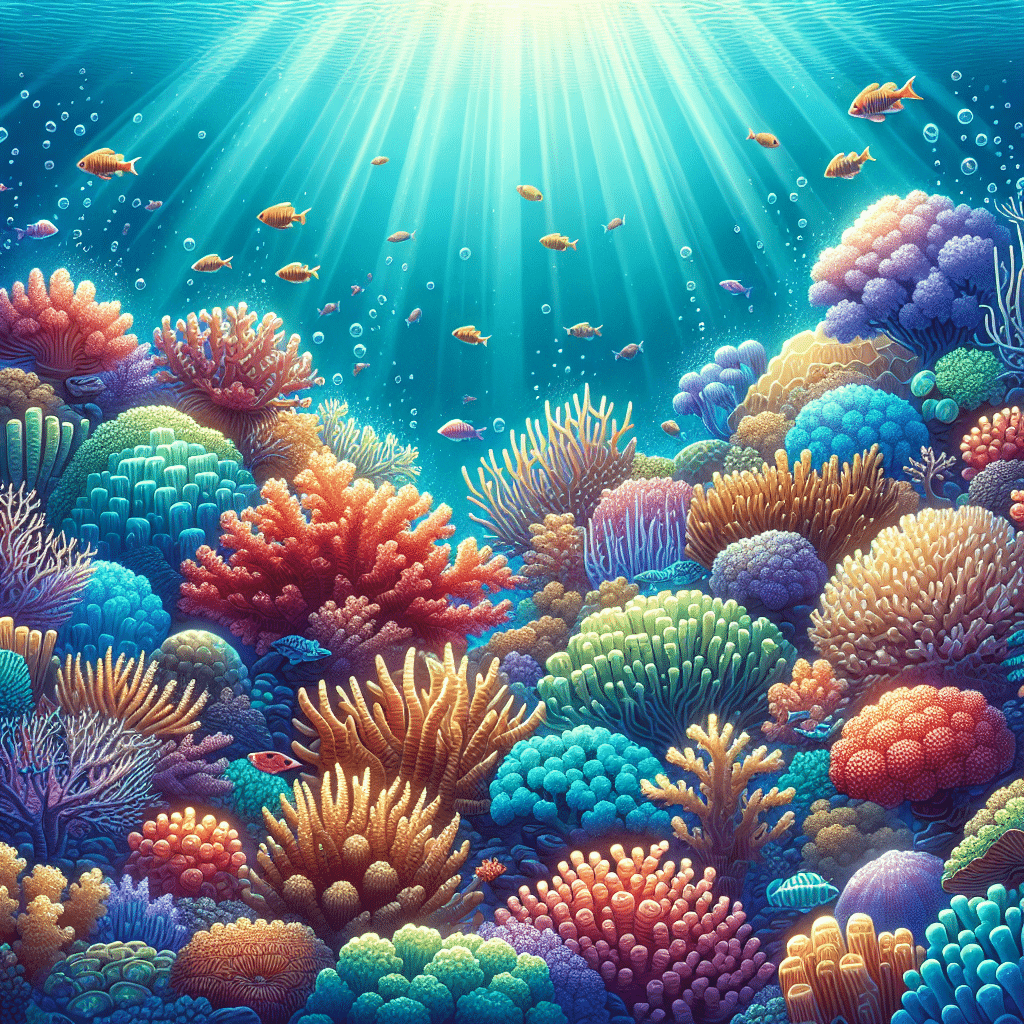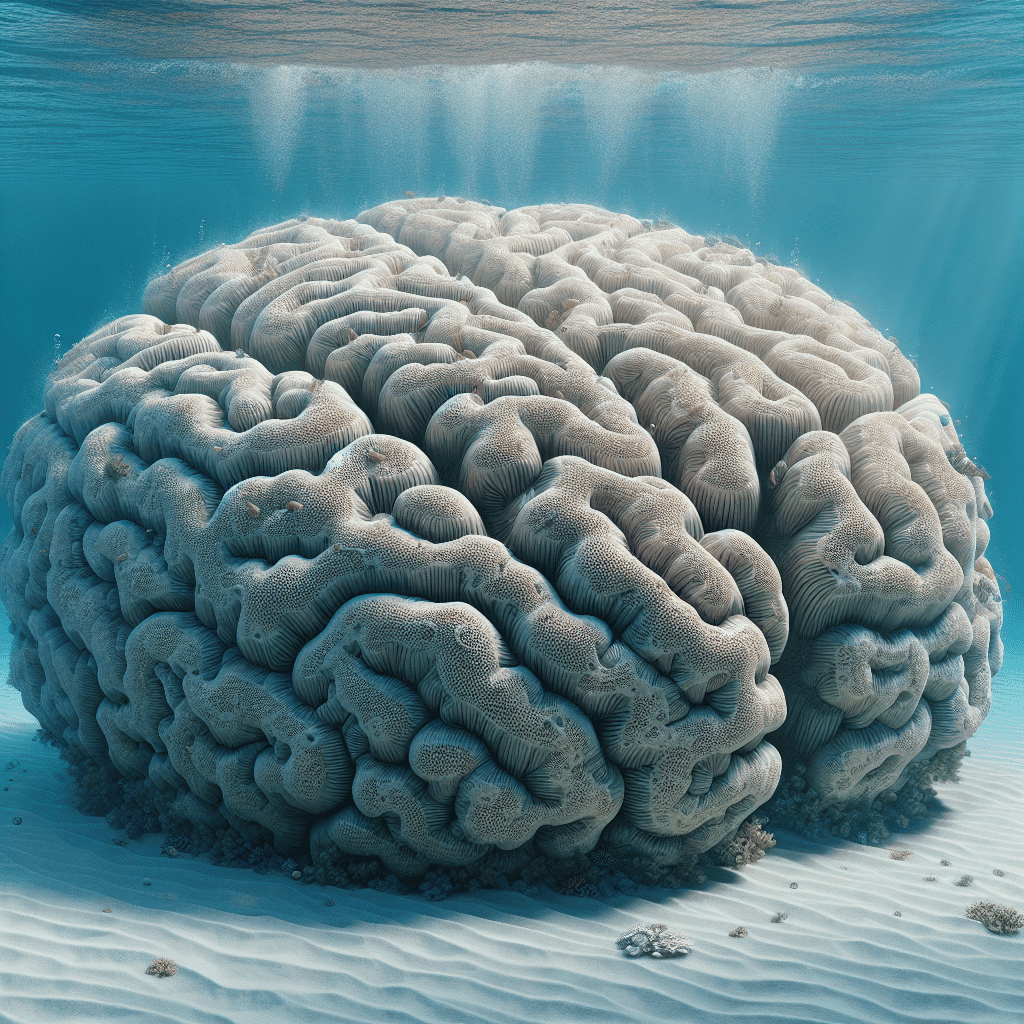Understanding Branching Corals
Branching corals are fascinating organisms that play a vital role in marine ecosystems. I love learning about their growth rates and how they contribute to reef formation, as well as the variations among different coral colonies.
Growth Rate and Contribution
Branching corals can grow up to 10 centimeters per year, which is impressive when you think about it. They contribute significantly to the formation of coral reefs, processes that can take up to 10,000 years to complete (NOAA). Their rapid growth makes them essential for the overall health of reef ecosystems.
These corals can also recover well from disturbances. If pieces are broken off by storms, they can disperse vegetatively, helping to regenerate the colony. This resilience is crucial for maintaining the structural integrity of coral reefs, especially after events like flooding (WetlandInfo).
| Growth Characteristics | Measurement |
|---|---|
| Maximum Growth Rate | Up to 10 cm/year |
| Reef Formation Duration | Up to 10,000 years |
Coral Colony Variations
Coral colonies can vary significantly in terms of their structure and composition. Branching corals often thrive in shallow to deep waters, constituting major reef-building corals in various habitats, including the outer Great Barrier Reef and inshore fringing reefs along the Queensland coastline.
Within these colonies, branching hard corals like Acropora and Isopora stand out as key players in upper mesophotic communities, found at depths of 30 to 60 meters. They can form extensive monospecific stands, like the Acropora tenella colonies that cover large areas in the Great Detached Reef.
These variations in colony structure and habitat highlight the adaptability of branching corals, showcasing their importance in maintaining biodiversity and providing habitat for numerous marine species.
| Colony Characteristics | Examples |
|---|---|
| Dominant Species | Acropora, Isopora |
| Depth Range | 30-60 meters for upper mesophotic communities |
Understanding these aspects of branching corals not only enhances my appreciation of them but also helps me as a hobbyist to create better environments in my reef tank. For more information on different types of corals, check out the section on corals.
Types of Coral Reefs
As I dive into the world of corals, I find it fascinating to learn about the different types of coral reefs. Each type has its unique characteristics and plays a crucial role in marine ecosystems. Here’s a closer look at four primary types of coral reefs: fringing reefs, barrier reefs, atolls, and patch reefs.
Fringing Reefs
Fringing reefs are the most common type of reef, growing near coastlines around islands and continents. They are typically separated from the shore by narrow, shallow lagoons. This proximity to land makes them accessible for observation and care, which is something I appreciate as a reef tank hobbyist.
| Characteristic | Description |
|---|---|
| Location | Near coastlines |
| Lagoon Type | Narrow and shallow |
| Common Species | Acropora, Montipora, and other branching corals |
For more information on specific corals found in fringing reefs, check out acropora and montipora.
Barrier Reefs
Barrier reefs run parallel to coastlines but are separated by deeper, wider lagoons. These reefs form a “barrier” to navigation at their shallowest points. Barrier reefs are larger than fringing reefs and can host a diverse array of marine life, making them a fantastic topic for exploration.
| Characteristic | Description |
|---|---|
| Location | Parallel to coastlines |
| Lagoon Type | Deeper and wider |
| Common Species | Torch coral, Brain coral, and various soft corals |
You might want to explore the beauty of torch coral or brain coral as you consider the species that thrive in these environments.
Atolls
Atolls are unique formations that create protected lagoons and are usually found in the middle of the sea. They form when islands surrounded by fringing reefs sink into the sea or when the sea level rises around them. The circular shape of atolls provides a special habitat for various marine species.
| Characteristic | Description |
|---|---|
| Location | Open ocean |
| Formation | Sinking islands or rising sea levels |
| Common Species | Xenia, Fan coral, and other soft corals |
If you’re interested in the soft coral species, take a look at xenia or fan coral that often inhabit these atolls.
Patch Reefs
Patch reefs are smaller, isolated reefs that grow up from the open bottom of the island platform or continental shelf. They are found between fringing reefs and barrier reefs and can vary greatly in size. Most patch reefs are not large enough to reach the surface of the water, but they still serve as vital habitats for marine life.
| Characteristic | Description |
|---|---|
| Location | Between fringing and barrier reefs |
| Size | Varies greatly |
| Common Species | Candy cane coral, Cactus coral, and other small corals |
For a closer look at some of the corals that inhabit patch reefs, consider researching candy cane coral or cactus coral.
Understanding these types of coral reefs helps me appreciate the diversity and complexity of marine ecosystems. Each reef type supports various species and contributes to the overall health of our oceans.
Importance of Coral Growth
Understanding the importance of coral growth is essential for anyone involved in reef tank care or simply interested in marine ecosystems. Corals, particularly branching corals, play a crucial role in both environmental and economic contexts.
Environmental Impact
Coral reefs are incredibly important to marine ecosystems. They serve as the primary habitat for a myriad of marine species, providing food, shelter, and breeding grounds. Branching corals are particularly significant as they create structural substrates that support various coral-dwelling fish and other marine life. Healthy coral reefs help maintain biodiversity and protect coastal areas from erosion and storm damage.
Corals also contribute to the overall health of ocean ecosystems. They participate in the carbon cycle and help stabilize the marine environment. Understanding coral growth is vital for protecting these natural habitats and ensuring the sustainability of reef ecosystems. As noted by the NCBI, controlling the growth of reef-building corals is essential for both natural reef preservation and coral aquaculture, which is gaining traction as a business.
Economic Significance
The economic value of coral reefs cannot be overstated. They are sources of food, natural products, and tourism, providing livelihoods for millions of people. Approximately 10% of the world’s population relies on coral reefs, either directly or indirectly NCBI. For example, the Great Barrier Reef sustains over 60,000 jobs, primarily in tourism, and contributes a staggering $6.4 billion annually to the Australian economy.
Branches of corals also enhance recreational activities such as snorkeling, fishing, and diving, which are significant contributors to local economies. Branching corals are viewed as valuable resources not only for their ecological roles but also for their recreational and aesthetic appeal. The health of these coral systems is crucial for sustaining these economic benefits, making it essential for hobbyists and reef tank enthusiasts to prioritize coral care and growth in their tanks.
In summary, the importance of coral growth extends beyond mere aesthetics; it encompasses environmental stability and economic viability, making it a vital focus for anyone passionate about marine life and coral ecosystems.
Factors Affecting Coral Growth
In my experience caring for corals, I’ve found that several key factors significantly influence their growth. Understanding these factors can help me create the best environment for my branching corals and ensure they thrive in my reef tank.
Temperature and pH
Coral growth is highly influenced by temperature and pH levels. Ideal temperature ranges typically fall between 75°F to 82°F (24°C to 28°C) for many coral species, including branching corals. Deviations from this range can lead to stress and hinder growth. The pH levels should also be maintained between 7.8 and 8.4. Maintaining these parameters is crucial for the health of my corals, as significant fluctuations can lead to poor growth or even mortality.
| Factor | Ideal Range |
|---|---|
| Temperature | 75°F – 82°F (24°C – 28°C) |
| pH | 7.8 – 8.4 |
Light and Iron Levels
Light is another vital factor for coral growth, especially for zooxanthellate corals, which rely on symbiotic algae for energy. In my tank, I ensure that the light intensity is appropriate for the specific corals I keep. Photon flux density (the amount of light available for photosynthesis) is positively correlated with growth and calcification. Branching corals need clear water to access sufficient light, particularly when placed at greater depths.
Iron levels also play a role in coral health. While exact iron levels can vary, I keep an eye on nutrient inputs in my tank to ensure my corals get what they need for optimal growth.
| Factor | Importance |
|---|---|
| Light | Essential for photosynthesis |
| Iron | Supports overall health |
Competition and Predation
Competition among corals can affect growth rates. Branching corals often compete for space and resources with other corals and marine organisms. In my reef tank, I try to position my corals to minimize competition and maximize growth potential.
Predation can also impact branching corals. Some fish and invertebrates feed on coral polyps, which can hinder growth. I find it helpful to research which fish are compatible with my coral species to minimize predation while still enjoying a vibrant reef environment.
Branching corals are not just important for their aesthetic appeal; they also create vital habitats for various marine species and support recreational activities like snorkeling and fishing (WetlandInfo). Understanding these factors helps me maintain a healthy and thriving reef tank, ensuring my corals grow beautifully. For more information on different types of corals, check out our section on corals.
The Great Barrier Reef
Overview and Importance
The Great Barrier Reef is truly a natural wonder. It’s the largest coral reef system in the world, spanning over 344,400 square kilometers, which is roughly the size of Japan. This incredible ecosystem comprises around 3,000 individual reef systems, 760 fringing reefs, 900 tropical islands, and about 300 coral cays (WWF-Australia).
What I find fascinating is its biodiversity. The reef is home to more than 1,600 species of fish, 133 species of sharks and rays, 30 species of whales and dolphins, and six of the seven sea turtle species. This rich variety makes it an essential part of the marine ecosystem and a vital resource for the world.
Economically, the Great Barrier Reef sustains over 60,000 jobs, primarily in tourism, and contributes about $6.4 billion annually to Australia’s economy (WWF-Australia). It not only provides food and natural products but also acts as a natural barrier protecting coastlines.
Decline and Conservation Efforts
Unfortunately, the health of the Great Barrier Reef has significantly declined over the past three decades. Causes include coastal developments, pollution, and human interference, along with multiple mass coral bleaching events triggered by global warming. The urgency for action to conserve and protect this iconic World Heritage Area cannot be understated (WWF-Australia).
Efforts to conserve the reef include stricter regulations on coastal development, initiatives to reduce pollution, and programs aimed at restoring damaged areas. The ongoing research and community involvement are crucial in the fight to preserve this incredible ecosystem for future generations.
For anyone involved in reef tank hobbies, understanding the importance and fragility of coral systems like the Great Barrier Reef is essential. It highlights the significance of responsible care and placement of corals in home aquariums to mimic these natural ecosystems. If you’re interested in learning more about various types of corals, check out our articles on acropora and staghorn coral.
Challenges Facing Branching Corals
Branching corals, like Acropora millepora and Pocillopora acuta, are beautiful and important components of reef ecosystems, but they face several challenges that can affect their health and survival. In my experience, understanding these challenges is crucial for anyone interested in keeping corals in a fish tank or reef tank.
Sensitivity to Stress
One of the main issues with branching corals is their sensitivity to stress. They can be heavily impacted by environmental factors such as heat stress, cyclones, and outbreaks of crown-of-thorns starfish. These corals have weaker skeletons compared to other types, which makes them more vulnerable to these stressors.
The stress can lead to several issues, including reduced growth rates and increased susceptibility to diseases. Keeping water quality stable, monitoring temperature, and ensuring the right light levels are essential to help reduce stress on these corals.
Impact of Bleaching Events
Coral bleaching is another significant threat to branching corals. This phenomenon occurs when the endosymbiotic photosynthetic dinoflagellates are expelled by the coral host due to stress, which results in a loss of pigmentation. This not only affects the visual appeal of the coral but can also lead to starvation, reduced growth, and increased mortality.
For instance, the Great Barrier Reef experienced severe bleaching events in 2016 and 2017, which had varying impacts on different reefs. Some areas faced significant mortality rates, with Rib reef experiencing about 78% mortality attributed to the presence of crown-of-thorns starfish (Springer).
As a hobbyist, it’s crucial to be aware of these challenges and take proactive steps to create an environment that minimizes stress and supports the health of branching corals. Regular monitoring and adjustments can make a big difference in the long-term success of your reef tank.
Coral Growth Patterns
Understanding how corals grow is essential for anyone involved in maintaining a reef tank. My experiences have shown that both seasonal variations and predictive factors play significant roles in the growth rates of branching corals.
Seasonal Variations
Coral growth rates can fluctuate significantly with the seasons. For example, studies have shown that the growth rates of Acropora millepora and Pocillopora acuta are notably higher during the summer months. Specifically, A. millepora exhibits a growth increase of about 35-40%, while P. acuta shows a growth spike of approximately 23-33% in the same period (Springer).
| Coral Species | Growth Rate Increase in Summer (%) |
|---|---|
| Acropora millepora | 35-40 |
| Pocillopora acuta | 23-33 |
This seasonal growth pattern is influenced by factors like temperature, light availability, and nutrient levels, which tend to be more favorable during warmer months. As a reef tank hobbyist, it’s important to monitor these conditions to replicate the ideal environment for coral growth.
Predictive Factors
Several factors can predict the growth success of branching corals. For Acropora millepora, chlorophyll a content is the most critical predictor of growth rate and overall visual health. In contrast, for Pocillopora acuta, a high visual health score correlates with increased growth rates.
Other key factors influencing coral growth include:
- Light Intensity: Corals that contain symbiotic algae rely heavily on light for photosynthesis. Higher photon flux density often correlates with enhanced growth and calcification (NCBI).
- Temperature and pH: Optimal ranges for temperature and pH levels are crucial for maintaining healthy coral growth.
- Nutrient Availability: Elements like iron and zinc can also impact growth rates significantly.
As I continue to explore coral care, understanding these predictive factors allows me to make informed decisions about lighting, feeding, and overall tank management to promote healthy branching coral growth. For more insights on specific coral types, check out the sections on acropora and zoanthids.
Branching Corals in Different Ecosystems
Mesophotic Coral Ecosystems
I find mesophotic coral ecosystems fascinating, especially when it comes to branching corals like Acropora and Isopora. These corals thrive at depths between 30 to 60 meters, often seen in large monospecific stands. For example, extensive Acropora tenella colonies can cover over 200 square meters on the Great Detached Reef in the far northern Great Barrier Reef.
The branching hard corals in these ecosystems are unique as they can be found exclusively below 40 meters depth. While they may be less common, their presence indicates a vibrant ecosystem capable of supporting diverse marine life. Additionally, branching corals might be found in shaded microhabitats at higher latitudes, demonstrating their adaptability to varying light conditions.
| Coral Type | Depth Range (meters) | Notable Characteristics |
|---|---|---|
| Acropora | 30 – 60 | Forms extensive colonies, often monospecific |
| Isopora | 30 – 60 | Similar growth patterns to Acropora, thrives in lower latitudes |
Depth and Water Clarity
When considering branching coral, I can’t stress enough how important water clarity is for their growth, especially in deeper waters. Hard corals, including branching varieties, require very clear water to allow sufficient light penetration. This is vital for photosynthesis, which supports their growth and health in deeper ecosystems.
The ideal conditions for branching corals include:
- High light levels: Essential for photosynthesis, especially in lower latitudes.
- Clear waters: Ensures that light can reach the corals, enabling their growth and survival.
- Low light tolerance: Some branching corals can also thrive in shaded areas, indicating their adaptability.
In summary, branching corals play a critical role in mesophotic ecosystems. Their ability to grow in various depths and conditions highlights their importance in maintaining the health and diversity of coral reefs. If you’re interested in exploring different types of corals further, check out our articles on acropora and staghorn coral for more insights.



